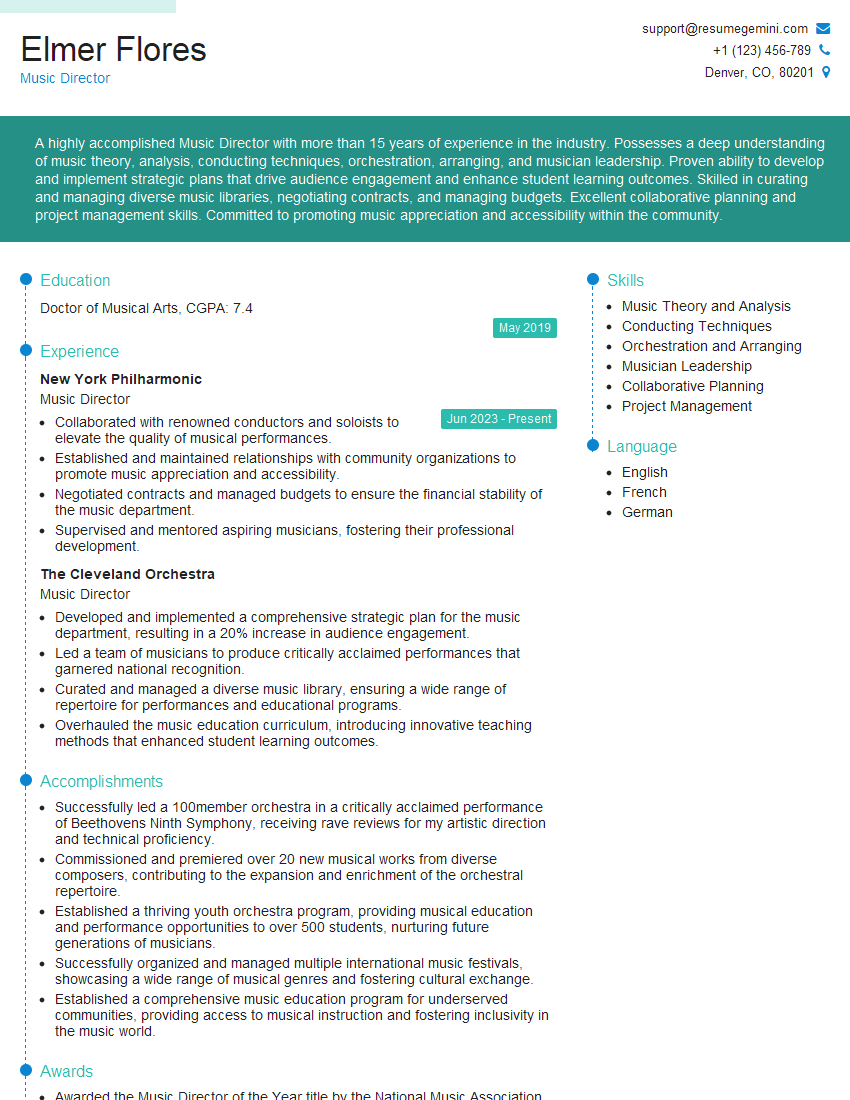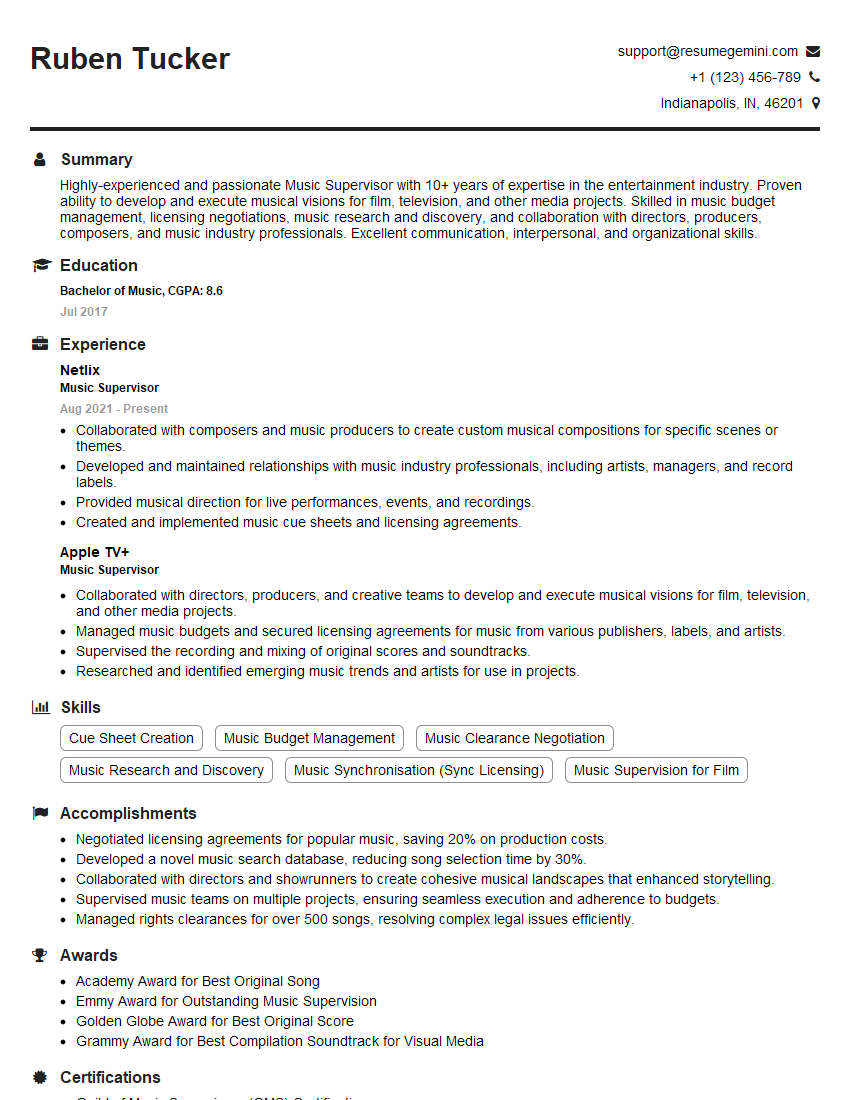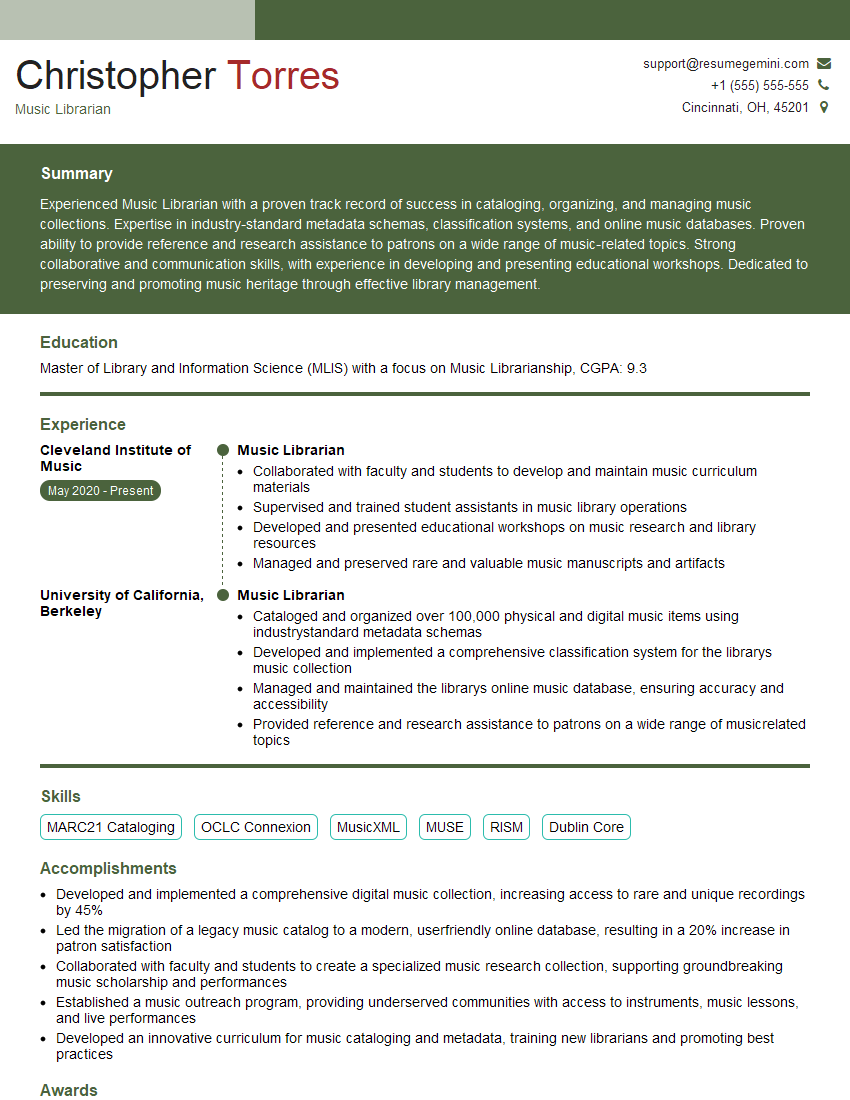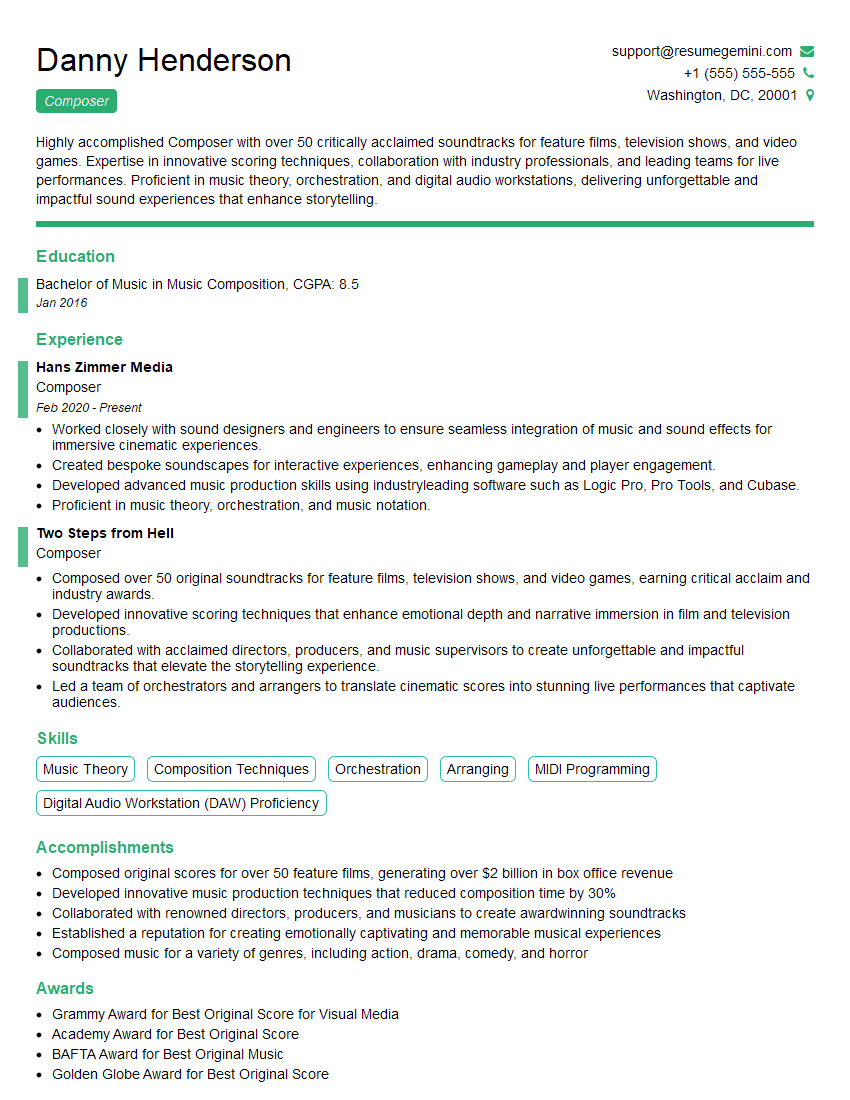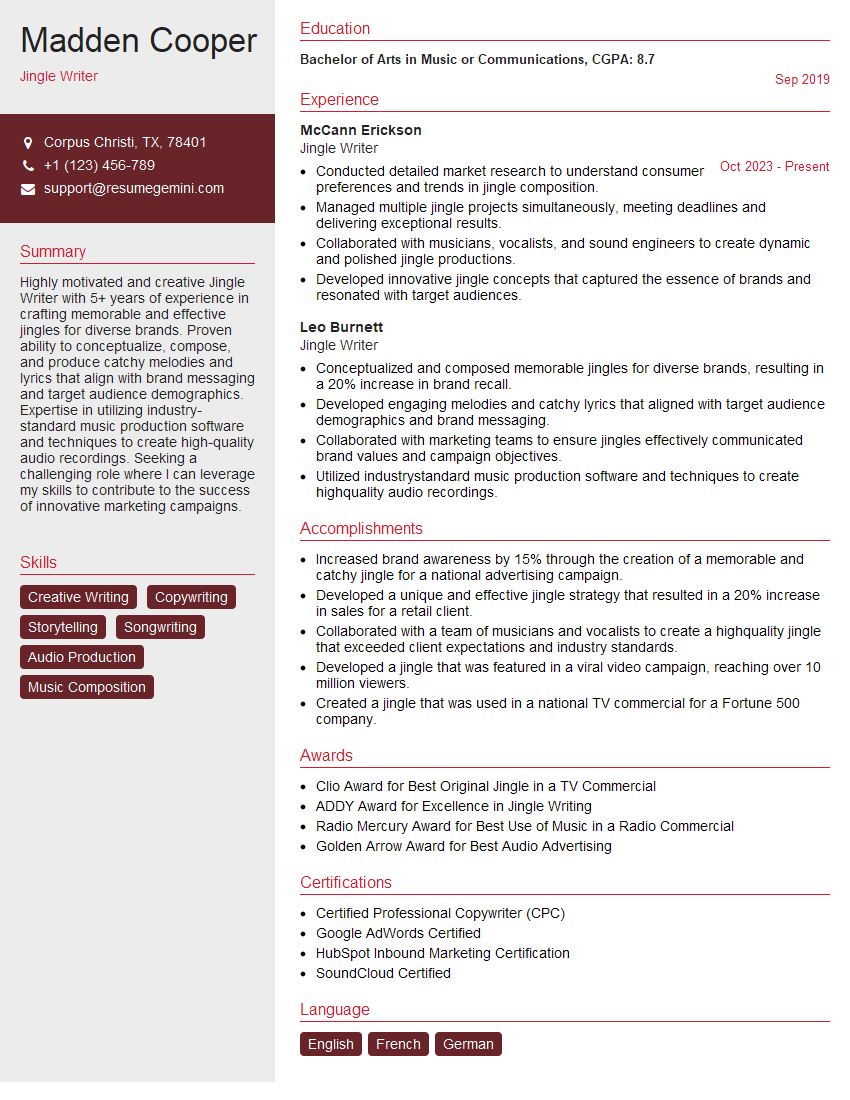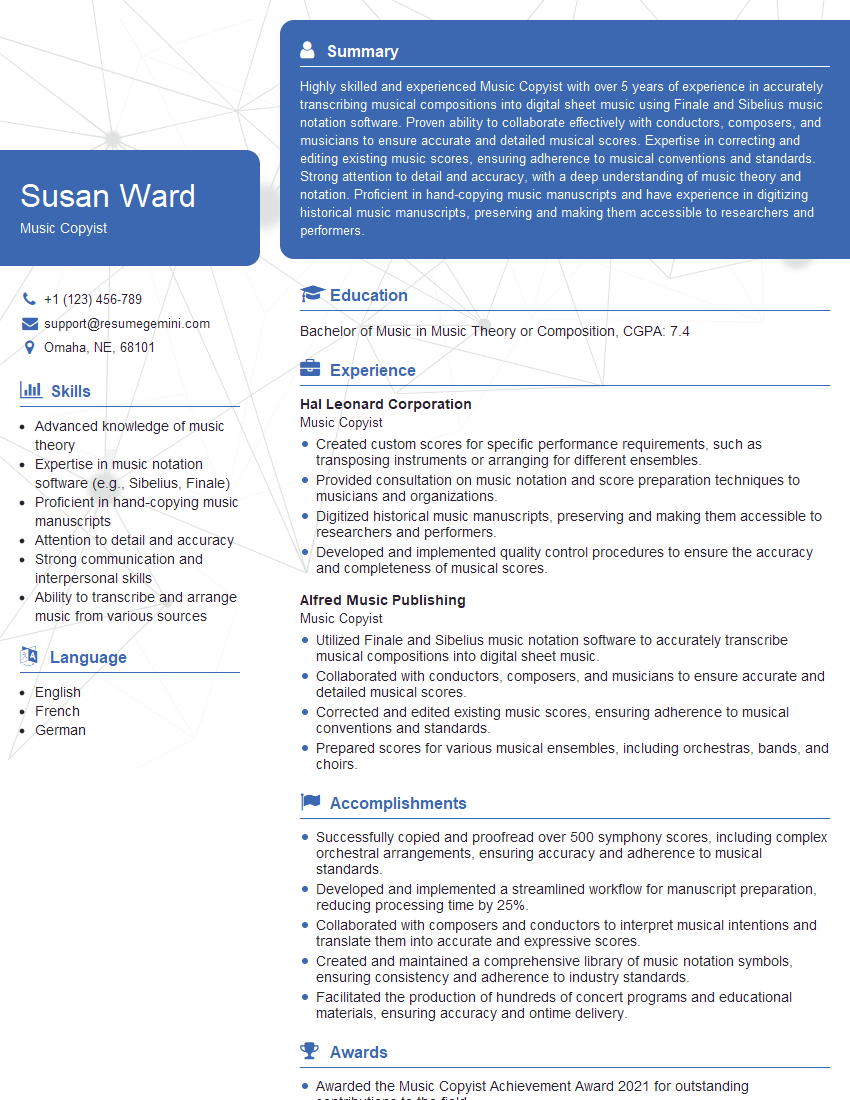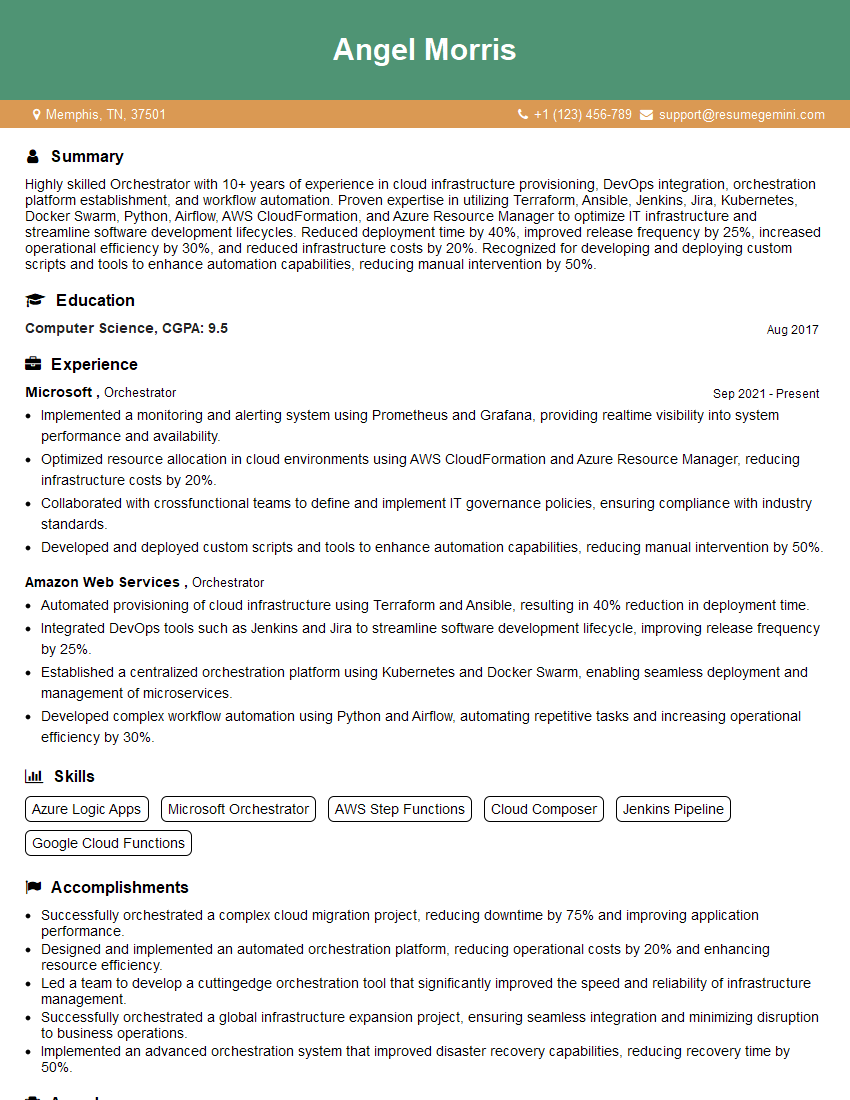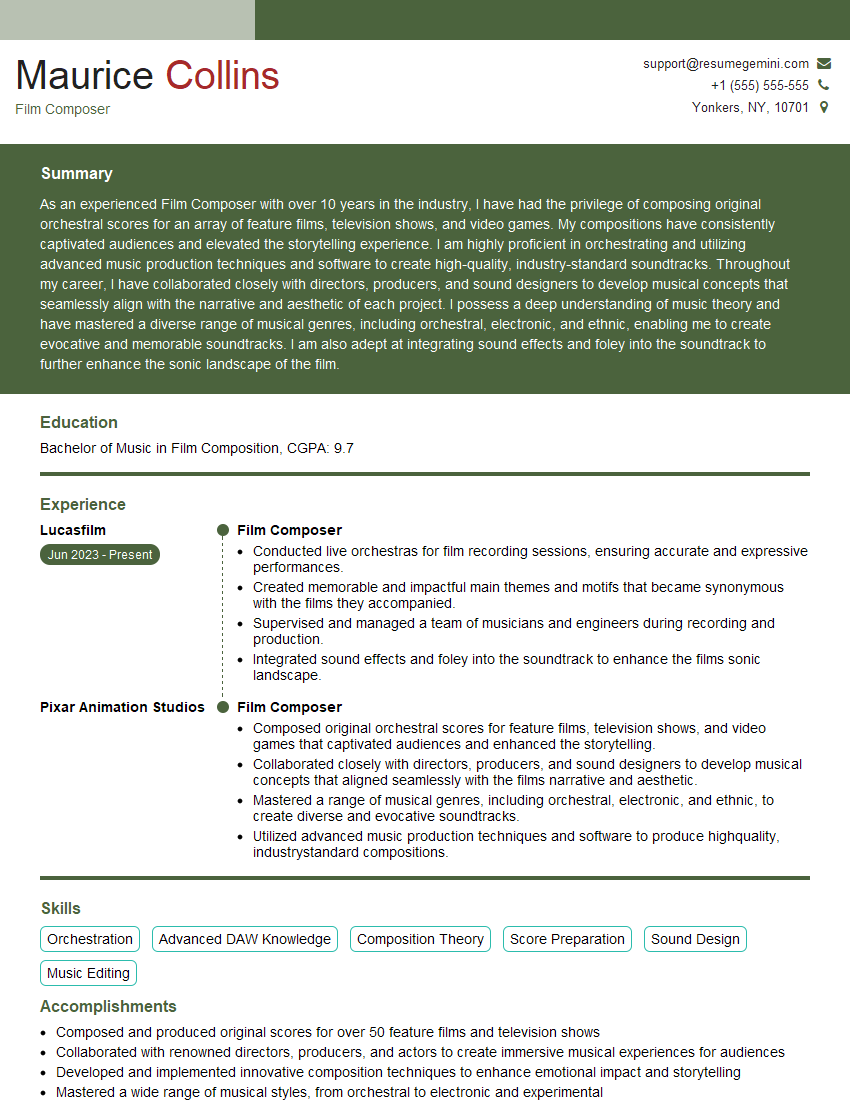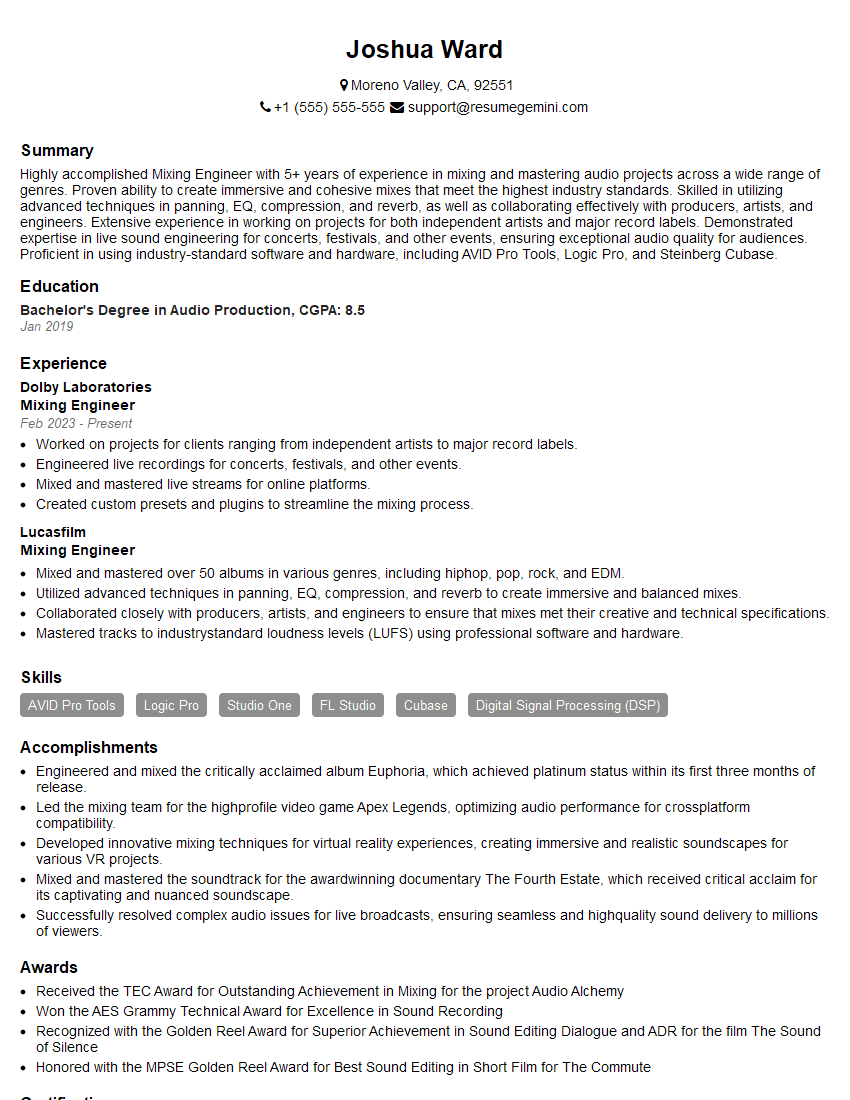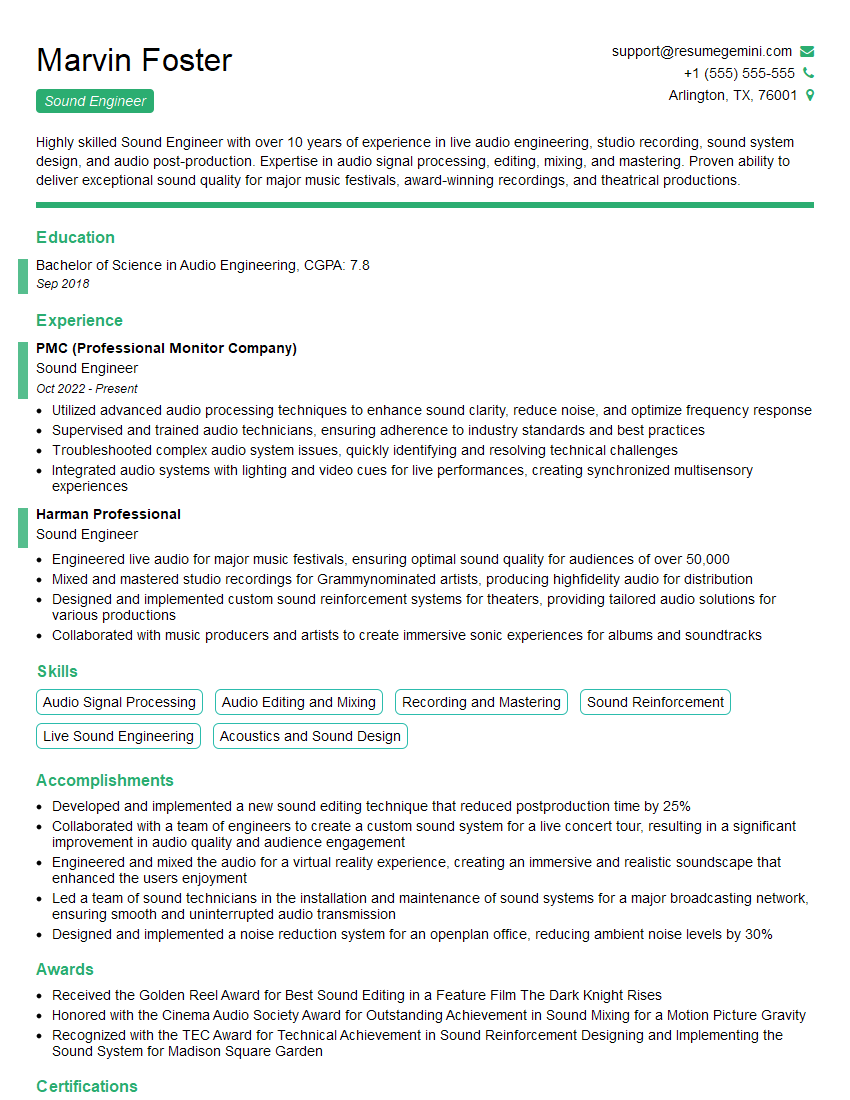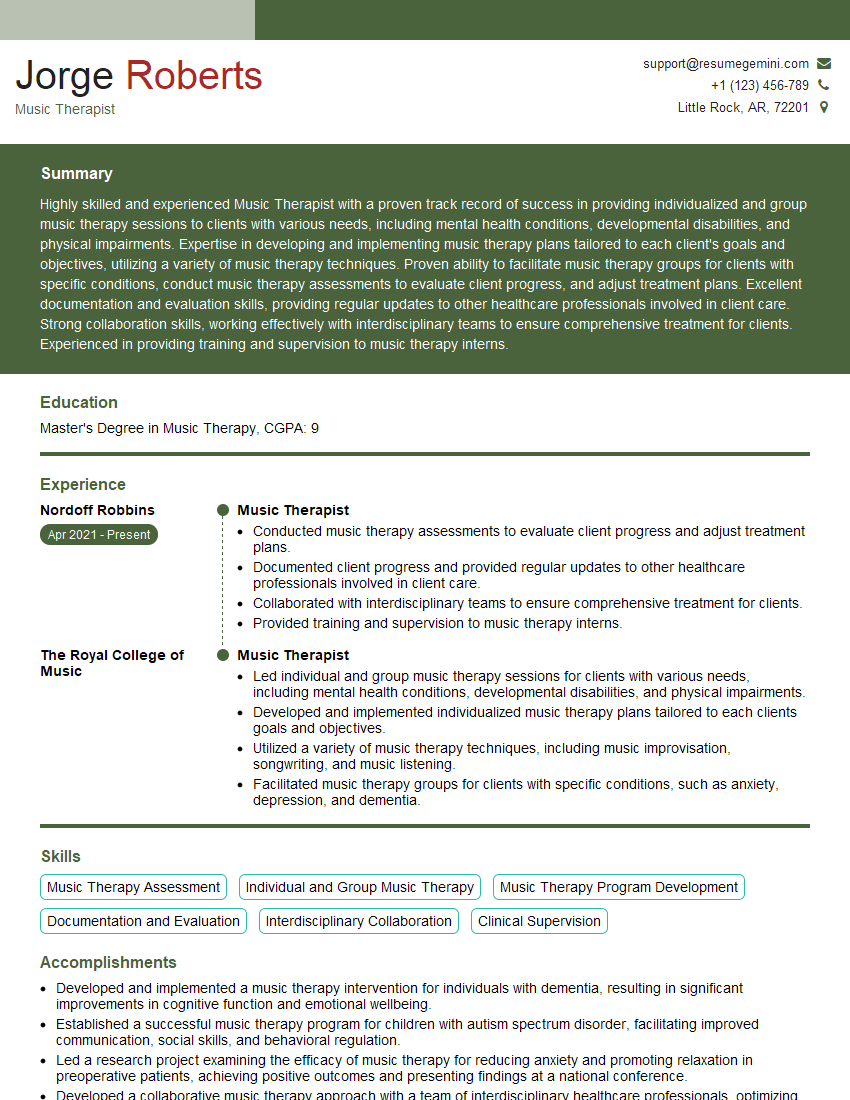Unlock your full potential by mastering the most common Songwriting and Original Music Composition interview questions. This blog offers a deep dive into the critical topics, ensuring you’re not only prepared to answer but to excel. With these insights, you’ll approach your interview with clarity and confidence.
Questions Asked in Songwriting and Original Music Composition Interview
Q 1. Describe your songwriting process.
My songwriting process is iterative and often begins with a spark – a catchy melody fragment, a powerful image, or a compelling story. I don’t adhere to a rigid structure, but generally follow these steps:
- Idea Generation: This phase involves brainstorming, freewriting, or simply letting my mind wander. I might record voice notes of lyrical ideas, melodic fragments hummed on my phone, or even just scribble down keywords or phrases that resonate.
- Melody & Harmony Development: Once I have a core idea, I usually start with the melody, experimenting with different instruments and scales to find the right feel. I’ll then build the harmonic structure (chords) around that melody, aiming for a pleasing and dynamic progression. This often involves playing around on my piano or guitar, but I also use digital audio workstations (DAWs) for more precise arrangement and experimentation.
- Lyric Writing: Lyrics come at different stages for me. Sometimes they’re inspired by the melody; other times, I write the lyrics first and compose the music to fit. I focus on crafting imagery, conveying emotion, and telling a story, aiming for authenticity and relatability.
- Arrangement & Production: This stage is about building the song’s sonic landscape. I select instrumentation, arrange the parts, and use mixing and mastering techniques to achieve the desired sound. This often involves collaboration with other musicians or producers.
- Refinement & Revision: I believe in the power of revision. I’ll often revisit a song multiple times, tweaking melodies, harmonies, lyrics, and arrangements until I’m completely satisfied. Feedback from trusted peers is invaluable at this stage.
For example, one song began with a simple guitar riff I developed while experimenting with a minor pentatonic scale. The melody then emerged naturally, followed by the lyrics, which told a story of loss and resilience.
Q 2. Explain your approach to melody writing.
My approach to melody writing is driven by emotion and storytelling. I strive for melodies that are both memorable and expressive, using various techniques to achieve this:
- Motivic Development: I often build melodies by repeating and varying short melodic phrases (motifs). This creates a sense of unity and progression within the song.
- Contour and Shape: I pay close attention to the melodic contour – the overall shape of the melody. A rising melody can convey hope, while a falling melody might express sadness. I experiment with stepwise motion, leaps, and rhythmic variations to create interesting shapes.
- Scale and Mode Selection: The choice of scale (e.g., major, minor, modal) significantly impacts the emotional character of the melody. Major scales often sound happy and bright, while minor scales can sound melancholic or mysterious.
- Rhythmic Variation: Rhythmic variation is crucial for preventing monotony. I use syncopation, rests, and varied note durations to keep the melody engaging.
For instance, in a recent ballad, I used a descending melodic line in a minor key to underscore the feeling of heartbreak, while the chorus employed a more uplifting major-key melody to highlight a sense of hope.
Q 3. How do you develop a unique musical style?
Developing a unique musical style is an ongoing process of experimentation and self-discovery. It involves combining various influences, refining your techniques, and continuously pushing creative boundaries. Here’s my approach:
- Embrace Influences, but Don’t Imitate: I draw inspiration from a wide range of artists and genres, but I strive to synthesize those influences into something original. It’s about understanding the essence of different styles and then reimagining them through my own lens.
- Experiment with Sounds and Textures: I constantly explore new instruments, sounds, and production techniques. This allows me to discover new sonic palettes and expand my expressive capabilities.
- Focus on Emotional Expression: Authenticity is key. I try to express my personal experiences, emotions, and perspectives in my music, which makes it inherently unique. This emotional core gives my work a distinctive stamp.
- Develop a Consistent Sonic Identity: Over time, a distinct style emerges naturally through consistent experimentation and refinement. Recurring melodic or harmonic patterns, characteristic rhythmic structures, and preferred instrumental textures contribute to this sonic identity.
My style, for example, is often described as a blend of indie-folk and alternative rock, marked by intimate vocals, layered acoustic guitar textures, and a subtle electronic undercurrent. It’s a style I’ve developed organically over years of exploration.
Q 4. Discuss your experience with different music genres.
My musical journey has spanned various genres, each enriching my understanding of music and influencing my songwriting. I’ve worked with:
- Classical Music: My early training in classical piano instilled a strong foundation in music theory and harmony.
- Folk Music: The simplicity and emotional directness of folk music have profoundly shaped my approach to songwriting.
- Rock and Pop: The energy and dynamism of rock and pop have influenced my arrangements and production techniques.
- Electronic Music: Exploring electronic music has introduced me to new sonic possibilities and production workflows.
This diverse experience allows me to approach songwriting with a broad perspective, blending elements from different genres to create unique sonic landscapes. For example, I might incorporate a classical-inspired string arrangement into a pop song or use electronic elements to enhance the texture of a folk ballad.
Q 5. How do you handle creative blocks?
Creative blocks are a common challenge for musicians. I’ve developed strategies to overcome them:
- Step Away and Recharge: Sometimes, the best solution is to take a break. I might go for a walk, listen to music, or engage in a different activity to clear my mind.
- Change Your Environment: A change of scenery can spark new ideas. I might work in a different room, visit a coffee shop, or even go on a trip to find inspiration.
- Collaborate with Others: Brainstorming with other musicians can be incredibly effective. Fresh perspectives and different approaches can help break through a creative rut.
- Experiment with Different Techniques: If I’m stuck on a particular aspect of a song, I’ll try experimenting with different approaches – altering the tempo, changing the key, or using a different instrument.
- Embrace Imperfection: Sometimes, striving for perfection can be counterproductive. I’ve found that letting go of expectations and simply creating something, even if it’s imperfect, can help break a block.
For instance, when I was struggling to finish a particular song, I collaborated with a friend who suggested a completely different melodic approach. His suggestion helped me unlock the song’s potential and complete it.
Q 6. Explain your understanding of music theory.
My understanding of music theory is extensive, encompassing various aspects:
- Harmony: I have a deep understanding of chord progressions, voice leading, and harmonic functions. This allows me to craft compelling and emotionally resonant harmonic structures.
- Melody: I’m proficient in melodic construction, utilizing scales, modes, and rhythmic variations to create memorable and expressive melodies.
- Rhythm and Meter: I understand various rhythmic patterns, syncopation, and meter changes, enabling me to create dynamic and engaging rhythmic structures.
- Form and Structure: I’m familiar with various song structures (e.g., verse-chorus, AABA) and can effectively utilize these to shape the narrative and emotional arc of my songs.
This theoretical knowledge isn’t just about following rules; it’s about understanding the underlying principles that govern music. It empowers me to make informed creative choices and push the boundaries of traditional structures.
For example, while composing, I might deliberately use a secondary dominant chord to create a sense of harmonic tension and release, or employ a rhythmic displacement to inject surprise and energy into a section.
Q 7. How do you incorporate lyrics into your compositions?
Integrating lyrics into my compositions is a delicate balance between musicality and poetic expression. My approach involves:
- Musicality of Lyrics: I strive for lyrics that are not only meaningful but also musically satisfying. This involves considering the rhythm, meter, and phrasing of the lyrics to complement the melody.
- Storytelling and Imagery: I use evocative language and imagery to create a narrative that enhances the emotional impact of the music.
- Vocal Delivery: The way the lyrics are sung is just as important as the words themselves. I experiment with different vocal styles and techniques to best convey the emotion and meaning of the lyrics.
- Collaboration (when applicable): Sometimes, I work with lyricists, and the process becomes a collaborative effort, bouncing ideas and refining the lyrics together.
For example, in one song, I focused on creating a rhythmic pattern in the lyrics that mirrored the driving beat of the drums, enhancing the song’s overall energy. In another, the sparse, almost whispered vocals complemented the delicate acoustic instrumentation to create an intimate and reflective mood.
Q 8. Describe your experience with music notation software.
My experience with music notation software is extensive. I’m proficient in several programs, including Sibelius, Finale, and Dorico. I use these tools not just for creating traditional scores but also for detailed arranging, orchestrating, and even generating MIDI data for use in my DAWs. For example, when composing a complex orchestral piece, Sibelius allows me to meticulously notate individual instrument parts, ensuring accurate voicing and dynamic balance. The ability to easily transpose sections, manipulate articulations, and create customized layouts is invaluable. Beyond the core functionality, I’m also adept at leveraging the advanced features – such as creating custom templates, utilizing playback functions for virtual instrument testing, and exporting files in various formats for collaborators.
Q 9. How do you collaborate with other musicians?
Collaboration is central to my creative process. I typically use a combination of methods depending on the project and the musicians involved. For smaller projects, we might use online platforms like Dropbox or Google Drive to share files. For larger, more complex projects, I prefer using dedicated collaboration tools like Soundtrap or a shared session within my DAW. This allows for real-time feedback and allows all collaborators to contribute simultaneously. Communication is key; I always establish clear expectations and regular check-ins to ensure everyone is on the same page. I find that building strong interpersonal relationships is as crucial as the technological aspects of collaboration; fostering trust enables open communication and creative problem-solving.
Q 10. How do you manage deadlines and project scope?
Managing deadlines and project scope requires careful planning and organization. Before starting a project, I thoroughly discuss the client’s vision, creating a detailed timeline with clearly defined milestones. I break down complex projects into smaller, manageable tasks. This approach makes progress transparent and helps identify potential roadblocks early on. For example, if composing a musical score for a film, I’ll create a detailed schedule outlining the composition, orchestration, and revision stages, allocating specific timeframes for each. I use project management software to track progress, maintain a comprehensive inventory of assets, and ensure deadlines are met. Open communication with clients is critical; regular updates and progress reports keep everyone informed and allow for flexibility if unexpected challenges arise.
Q 11. What are your preferred DAWs (Digital Audio Workstations)?
My preferred DAWs are Logic Pro X and Ableton Live. Logic Pro X provides a robust and intuitive environment for composing, arranging, and mixing, particularly for larger projects with complex instrumentation. Its extensive virtual instrument library and powerful MIDI editor are invaluable. Ableton Live, on the other hand, excels in its workflow for electronic music production and improvisation. Its session view allows for flexible arrangement and spontaneous composition. The choice between the two depends on the specific demands of the project; for example, I might use Logic Pro X for scoring a film, while employing Ableton Live for creating a dance track.
Q 12. Explain your mixing and mastering techniques.
My mixing and mastering techniques are based on a combination of technical expertise and artistic judgment. During mixing, I focus on achieving a balanced and cohesive sonic landscape, using equalization (EQ), compression, and other processing tools to shape individual tracks and create a harmonious blend. My approach is iterative, involving repeated listening sessions to fine-tune the levels and dynamics. Mastering involves optimizing the overall loudness, frequency balance, and dynamic range of the final mix. I meticulously analyze the stereo image, paying close attention to the low-end frequencies to avoid muddiness and ensure the track translates well across various playback systems. This often involves using high-quality mastering plugins and employing techniques like multiband compression and limiting to create a polished and radio-ready product. I always prioritize maintaining the musicality and integrity of the original composition during both mixing and mastering processes.
Q 13. How familiar are you with music copyright and licensing?
I am very familiar with music copyright and licensing. I understand the importance of protecting my intellectual property and adhering to the legal frameworks surrounding music usage. I’m aware of different types of licenses, such as mechanical licenses (for reproducing recordings), performance licenses (for public performances), and synchronization licenses (for use in film, television, or advertising). I typically consult with legal professionals to ensure all licenses are appropriately secured, especially for projects involving third-party collaborations or commercial releases. I also maintain meticulous records of my compositions and any agreements related to their usage. Understanding copyright law is crucial for preventing legal issues and ensuring fair compensation for my creative work.
Q 14. Describe a challenging project and how you overcame it.
One particularly challenging project involved composing a complex orchestral score for a historical drama with a very tight deadline. The initial brief was quite vague, and several revisions were requested throughout the process. To overcome this, I implemented a rigorous project management system, breaking the score into manageable sections and setting achievable daily goals. I also established clear communication channels with the director and producer, ensuring that all revisions were thoroughly discussed and understood. By proactively addressing potential issues and maintaining consistent communication, I was able to deliver a high-quality score on time, despite the challenges presented by a vague brief and the demanding timeframe. Learning to adapt to changing demands and prioritize clear communication proved crucial in successfully completing this project.
Q 15. How do you adapt your music to different media (film, games, etc.)?
Adapting music to different media requires a deep understanding of the narrative and emotional landscape of the project. It’s not just about slapping a soundtrack on; it’s about crafting a sonic experience that complements and enhances the visual storytelling. For film, for example, I’d consider the pacing of the scenes. A tense chase scene requires fast-paced, driving music, whereas a quiet, intimate moment might need a delicate, melancholic melody. In games, interactivity is key. I might compose modular music that adapts dynamically based on player actions, adding layers of intensity during combat or shifting to a more ambient texture during exploration. For instance, I might create a core musical theme that can be arranged in various ways: a driving version for action, a quieter, more mysterious version for stealth sequences, and a triumphant version for victory.
In practice, this involves close collaboration with the director or game designer. I’ll receive storyboards, script outlines, or game design documents to understand the emotional arc and pacing. Then, I’ll create a musical framework that aligns with those elements, often experimenting with different instrumentation and textures to match the visuals. I might use specific instruments to evoke certain feelings – for example, string instruments for sadness, brass for triumph, percussion for action.
Career Expert Tips:
- Ace those interviews! Prepare effectively by reviewing the Top 50 Most Common Interview Questions on ResumeGemini.
- Navigate your job search with confidence! Explore a wide range of Career Tips on ResumeGemini. Learn about common challenges and recommendations to overcome them.
- Craft the perfect resume! Master the Art of Resume Writing with ResumeGemini’s guide. Showcase your unique qualifications and achievements effectively.
- Don’t miss out on holiday savings! Build your dream resume with ResumeGemini’s ATS optimized templates.
Q 16. How do you ensure your music is accessible to a broad audience?
Creating accessible music hinges on balancing originality with familiarity. While I strive for unique musical ideas, I also ensure the melodies and harmonies are generally pleasing and memorable. Think of it like building a house – you need a strong foundation of relatable elements (like common chord progressions) before adding the unique architectural details that make it stand out. I use diatonic harmonies – those found within a single key – most of the time to provide harmonic stability and familiarity. However, I will then spice things up by occasionally employing chromatic notes or unexpected harmonic shifts to create intrigue.
Simplicity is key. Overly complex melodies or rhythms can alienate listeners. Instead, I focus on creating catchy hooks and memorable motifs that are easy to grasp on first listen. Strong melodic lines are crucial. I also take into account rhythmic complexity. Rhythmically diverse music that maintains a certain level of predictability is often more accessible than something that is constantly chaotic and unpredictable.
Finally, I always consider the target audience. Understanding their musical preferences and cultural background informs my compositional choices. For example, a piece intended for children will differ drastically from one intended for a sophisticated concert audience. I research different genres to identify elements that resonate with broad audiences while retaining my own style.
Q 17. What are your strengths and weaknesses as a songwriter/composer?
My strengths lie in melody writing and creating emotionally resonant musical landscapes. I have a knack for crafting memorable melodies that stick with the listener, and I’m skilled at weaving those melodies into compelling harmonic structures. I also excel at arranging and orchestrating, finding creative ways to utilize different instruments to build sonic textures. For instance, I once created a piece of music for a film that used subtle changes in the orchestration to reflect the character’s internal emotional shifts, a nuance that wouldn’t be readily apparent to the casual listener, but adds significantly to the experience.
However, my weakness is sometimes getting lost in the details. I can become overly focused on intricate musical textures or complex arrangements, sometimes at the expense of the overall simplicity and accessibility of the piece. I’m actively working on improving this by consciously focusing on the impact of my musical ideas rather than getting bogged down in technical virtuosity. I also sometimes struggle with self-criticism, leading to perfectionism and potentially missing deadlines. To counter this, I’ve incorporated regular feedback sessions and more defined project management into my workflow.
Q 18. How do you handle feedback and criticism?
I embrace feedback and criticism as invaluable opportunities for growth. It’s crucial to remember that constructive criticism isn’t a personal attack but a chance to refine my work and learn from others’ perspectives. My approach involves active listening. I carefully consider every point, asking clarifying questions when needed. I try to understand the rationale behind the feedback, even if I don’t initially agree with it.
I differentiate between constructive criticism focused on the music itself and personal opinions. Constructive criticism often points to specific elements that could be improved, such as ‘the melody in section B feels repetitive’ or ‘the mix could benefit from a clearer bassline’. Personal opinions, while valuable for understanding audience response, may be less directly applicable to revising the music itself. I try to use a filter to weigh feedback based on its technical value and relevance to the specific aims of the project.
Finally, I document all feedback and use it to inform future projects. I maintain a log of notes and revisions, which allows me to see patterns and identify areas where I consistently need improvement. This systematic approach helps me to transform criticism into positive change.
Q 19. Explain your understanding of harmony and counterpoint.
Harmony is the simultaneous sounding of multiple notes, creating chords and progressions that generate a sense of consonance (pleasantness) or dissonance (tension). It’s the foundation of music’s emotional impact. For instance, a major chord often sounds happy and bright, while a minor chord can sound sad or mysterious. I use harmony to shape the emotional arc of a piece, building tension and release through the strategic use of chord changes. Understanding harmony involves knowledge of scales, chords (major, minor, diminished, augmented), inversions, and chord progressions.
Counterpoint, on the other hand, is the art of combining independent melodic lines simultaneously. It’s like a conversation between different musical voices. Each line has its own independent character, yet they work together harmoniously. This requires a deep understanding of voice leading (how melodies move smoothly between notes), rhythmic interplay, and avoiding clashes between melodic lines. A classic example of counterpoint can be found in the works of Bach, where multiple independent melodies intertwine beautifully.
In my work, I often use counterpoint to create richer and more intricate musical textures. A simple melody can be significantly enhanced by adding a countermelody that complements and contrasts it, adding depth and complexity without overwhelming the listener. For example, I’ll often use a simple bass line as a counterpoint to a more complex melody, creating a dynamic interplay between the two.
Q 20. What is your approach to instrumentation and orchestration?
My approach to instrumentation and orchestration is guided by the emotional and narrative context of the music. I don’t just randomly choose instruments; I carefully select each one based on its timbre (tone quality) and expressive capabilities. The choice of instruments significantly impacts the overall mood and feeling of the piece.
For instance, string instruments (violins, violas, cellos) are often used to create lush, emotional textures, while brass instruments (trumpets, trombones) can evoke a sense of grandeur or power. Woodwinds (flutes, clarinets, oboes) bring a softer, more lyrical quality, and percussion instruments add rhythmic drive and excitement. I often create sketches using only a piano or guitar to develop the melodic and harmonic foundation before experimenting with different instrumental combinations.
Orchestration involves arranging the music for a specific ensemble of instruments. This requires a thorough understanding of each instrument’s range, capabilities, and expressive potential. It’s about balancing the different instrumental voices to create a cohesive and impactful sonic tapestry. For example, I might use a solo violin to create a sense of intimacy, or a full brass section to build a powerful climax. The process of orchestration involves careful consideration of dynamics, balance, and texture, ensuring that each instrument contributes meaningfully to the overall effect.
Q 21. How do you use technology to enhance your music?
Technology plays a crucial role in my music creation process. Digital Audio Workstations (DAWs) like Logic Pro X or Ableton Live are essential tools. They allow me to record, edit, and mix audio, experiment with virtual instruments, and create complex arrangements with ease. DAWs provide a flexible and efficient workflow, making it possible to refine musical ideas rapidly and explore different sonic palettes.
Virtual instruments (VSTs) offer access to a vast library of sounds beyond what’s available with physical instruments. This expands my creative possibilities enormously. I can experiment with different synthesizers, orchestral samples, and effects processors to create unique soundscapes. For example, I might use a synthesizer to create a futuristic soundscape for a science fiction film or employ sampled orchestral instruments to create a grandiose score for a fantasy game. The combination of software-based and physical instruments is often more creative and richer.
Furthermore, I utilize audio editing software and mastering tools to enhance the sound quality and polish the final product. This ensures the music is properly balanced, has a consistent dynamic range, and sounds professional. The use of digital technology allows for greater precision in my music creation and allows me to deliver high-quality results to my clients.
Q 22. Describe your experience working with vocalists.
Working with vocalists is a deeply collaborative process, requiring sensitivity, technical understanding, and a strong communicative approach. It’s about more than just the final product; it’s about building a relationship based on trust and mutual respect.
My approach begins with understanding the vocalist’s strengths and range. I carefully consider their vocal timbre, phrasing style, and emotional expression when composing melodies and harmonies. I often provide demo recordings of the vocal lines, demonstrating the intended phrasing and emotional arc. This allows the vocalist to grasp the vision clearly, and provides a foundation for their interpretation.
For example, I once worked with a vocalist who had a powerful belt but struggled with delicate high notes. Instead of pushing them beyond their comfort zone, I adjusted the melody, creating a range that celebrated their strengths while gently navigating their limitations. This resulted in a stunning vocal performance that felt both powerful and vulnerable.
Beyond musical aspects, effective communication is paramount. I encourage open dialogue, providing constructive feedback while respecting their artistic input. The goal is to create a space where the vocalist feels empowered to contribute their unique talents, fostering a truly collaborative and creative environment.
Q 23. How do you balance artistic vision with commercial viability?
Balancing artistic vision with commercial viability is a delicate dance—a constant negotiation between creative integrity and market demands. It’s not about compromising your artistic vision; rather, it’s about finding innovative ways to present that vision to a wider audience.
For me, this starts with a deep understanding of my target audience. Who am I writing for? What are their musical preferences? Understanding this helps me tailor certain aspects of the composition without sacrificing the core artistic message. For instance, I might experiment with incorporating popular chord progressions or rhythmic structures that are currently trending, but always infused with my unique stylistic elements.
One example is incorporating elements of popular genres into my original compositions. If my core artistic vision leans towards a more experimental sound, I might incorporate elements of pop or folk music—elements that will broaden the appeal of the composition without compromising my distinctive style.
Ultimately, it’s about crafting a song that is both artistically satisfying and commercially viable – a song that resonates with both my creative spirit and a wider audience.
Q 24. What inspires your music?
My musical inspiration draws from a myriad of sources: personal experiences, observations of the world around me, literature, art, and other music itself. It’s a constant process of absorbing and processing stimuli, transforming them into musical narratives.
For example, a poignant conversation with a loved one might inspire a melancholic ballad, while a vibrant street scene could spark a lively, upbeat composition. Reading a compelling novel could lead to exploration of thematic complexities through music, or the visual dynamics of a painting could influence instrumentation and harmony.
I believe inspiration can be found everywhere if you are open to seeing the musical potential within it. I actively seek out new experiences, nurture my curiosity, and constantly expose myself to diverse art forms to fuel my creativity.
Q 25. How do you stay updated on current music trends?
Staying updated on current music trends is crucial for any composer. It’s not about blindly following trends, but rather about understanding the evolving musical landscape and adapting to it. This allows me to maintain a relevant approach while retaining my unique artistic voice.
My methods include actively listening to a wide range of contemporary artists across genres, attending live performances, and engaging with online music communities and platforms. Music blogs, podcasts dedicated to music industry analysis, and streaming service charts are incredibly helpful in identifying emerging trends and understanding broader audience preferences.
I also pay close attention to how technology is shaping music production and distribution. New instruments, software, and platforms constantly emerge, influencing how music is composed, produced and experienced. Staying informed about these developments is essential to remaining competitive and innovative.
Q 26. Describe your proficiency in different musical instruments.
My proficiency spans several instruments, each contributing unique textures and perspectives to my compositions. I am most fluent in piano and guitar. The piano provides a solid foundation for harmonic development and composition, while the guitar offers a more intimate and expressive voice.
I’m also proficient in basic bass guitar and drums. This allows me to create more comprehensive demos and fully realized sonic landscapes during the composition process. I understand their roles within an ensemble, and can effectively write parts that complement and enhance the overall sonic texture of a piece.
Beyond these, I have a working knowledge of various orchestral instruments, which allows me to score effectively for larger ensembles. My understanding of these instruments’ timbral qualities informs my compositional choices and orchestration, resulting in more nuanced and evocative works. This understanding isn’t limited to technical proficiency but also incorporates an understanding of the expressive capabilities of each instrument within a musical context.
Q 27. Explain your knowledge of different musical forms and structures.
My understanding of musical forms and structures is extensive, encompassing various genres and historical periods. From basic forms like verse-chorus structures in pop music to more complex forms like sonata form in classical music, I am comfortable navigating and manipulating different musical architectures.
I am familiar with a range of compositional techniques, including counterpoint, motivic development, and harmonic analysis. This knowledge allows me to create diverse and compelling musical narratives. I can write songs using standard structures, or I can experiment with more unconventional approaches, seamlessly blending different forms to create unique compositions.
This includes understanding the nuances of various musical periods – baroque, classical, romantic, etc. – to better leverage their specific harmonic and structural vocabulary. Each period offers unique tools, and I can draw upon them in crafting unique musical approaches.
Q 28. What are your long-term career goals in music?
My long-term career goals revolve around establishing myself as a respected and sought-after composer and songwriter. This includes a diverse portfolio of work, encompassing film scores, video game soundtracks, original albums, and collaborations with other artists.
I aim to continually push creative boundaries, exploring innovative musical ideas and techniques. I also want to nurture a strong and collaborative working relationship with other artists and producers, fostering a network of creative support and mutual inspiration.
Ultimately, my greatest aspiration is to create music that resonates deeply with audiences, touching hearts and enriching lives through evocative storytelling and memorable melodies. I envision continued learning and growth, always refining my craft and expanding my creative horizons.
Key Topics to Learn for Songwriting and Original Music Composition Interview
- Melody and Harmony: Understanding melodic construction, harmonic progressions, and voice leading. Practical application: Analyze your own work and the work of established songwriters to identify effective melodic and harmonic choices.
- Rhythm and Meter: Mastering rhythmic complexity, syncopation, and the interplay between rhythm and melody. Practical application: Experiment with different rhythmic patterns and meters to create unique grooves and textures.
- Form and Structure: Knowing various song structures (verse-chorus, AABA, etc.) and how to effectively use them to create compelling narratives. Practical application: Outline your song structures before composing to ensure a coherent and engaging listening experience.
- Lyrical Content and Storytelling: Developing strong lyrical themes, crafting meaningful narratives, and using imagery and metaphor effectively. Practical application: Practice writing lyrics that tell a story and evoke emotion in the listener.
- Instrumentation and Arrangement: Understanding the roles of different instruments and how to arrange them to create a cohesive sonic landscape. Practical application: Experiment with different instrument combinations and arrangements to find the best fit for your songs.
- Music Theory Fundamentals: Solid grasp of scales, chords, intervals, and key signatures. Practical application: Use theoretical knowledge to consciously create harmonies and melodies that support your artistic vision.
- Production Techniques: Basic understanding of recording, mixing, and mastering techniques. Practical application: Learn the basics of DAW software to be able to effectively showcase your compositions.
- Genre Awareness: Understanding the stylistic conventions and expectations of different musical genres. Practical application: Tailor your songwriting and compositional approaches based on the intended genre.
- Copyright and Publishing: Understanding the legal aspects of music copyright and publishing. Practical application: Protect your creative work and understand the processes involved in getting your music heard.
Next Steps
Mastering songwriting and original music composition is crucial for a successful career in the music industry. It allows you to showcase your creativity, technical skills, and artistic vision. To maximize your job prospects, creating an ATS-friendly resume is essential. ResumeGemini is a trusted resource that can help you build a professional and impactful resume tailored to your skills and experience. Examples of resumes specifically designed for Songwriting and Original Music Composition professionals are available to help you get started.
Explore more articles
Users Rating of Our Blogs
Share Your Experience
We value your feedback! Please rate our content and share your thoughts (optional).
What Readers Say About Our Blog
Hello,
We found issues with your domain’s email setup that may be sending your messages to spam or blocking them completely. InboxShield Mini shows you how to fix it in minutes — no tech skills required.
Scan your domain now for details: https://inboxshield-mini.com/
— Adam @ InboxShield Mini
Reply STOP to unsubscribe
Hi, are you owner of interviewgemini.com? What if I told you I could help you find extra time in your schedule, reconnect with leads you didn’t even realize you missed, and bring in more “I want to work with you” conversations, without increasing your ad spend or hiring a full-time employee?
All with a flexible, budget-friendly service that could easily pay for itself. Sounds good?
Would it be nice to jump on a quick 10-minute call so I can show you exactly how we make this work?
Best,
Hapei
Marketing Director
Hey, I know you’re the owner of interviewgemini.com. I’ll be quick.
Fundraising for your business is tough and time-consuming. We make it easier by guaranteeing two private investor meetings each month, for six months. No demos, no pitch events – just direct introductions to active investors matched to your startup.
If youR17;re raising, this could help you build real momentum. Want me to send more info?
Hi, I represent an SEO company that specialises in getting you AI citations and higher rankings on Google. I’d like to offer you a 100% free SEO audit for your website. Would you be interested?
Hi, I represent an SEO company that specialises in getting you AI citations and higher rankings on Google. I’d like to offer you a 100% free SEO audit for your website. Would you be interested?
good
